When I was young, my mom had a simple rule: eat the “good” food first. The idea was to fill up on nutrients before indulging in dessert. Time and time again, I asked for a sweet treat before dinner (you think I would learn), and my mom always reminded me of the family rule. While I sometimes forgot the rule as a kid, the lesson sticks with me today — eat what you need first, and then enjoy the extras.
As adults, we flip this advice on its head. We treat ourselves first—concert tickets, a new outfit, a shiny car—and then find ourselves at the end of the month wondering why our savings goals remain out of reach. How can we ensure that our financial “nutrients” are covered and still have space left for dessert? It’s all about how we fill our budget plate.
The First Bite: Giving Back
For many, the first portion goes to giving—supporting causes you care about. How much do you want to contribute? Automate this process. Schedule an automatic transfer to a savings account earmarked for charitable giving or make those donations right away. When it’s automatic, you ensure this important piece doesn’t get squeezed out.
The Protein: Long-Term Savings
Next comes long-term savings–the protein of your financial meal–fueling your future. A good rule of thumb is to aim for 15% of your income, but tailor it to your circumstances (or ask an advisor at PYA Waltman–because everyone’s financial lives are different!). Set up automatic contributions to your retirement account or investment portfolio. Treat these savings as non-negotiable—just like the protein your body needs, your future depends on this.
Complex Carbs: Short-Term Savings
Now, think about short-term savings—like complex carbs, these are for the near future and help even out blood sugar... I mean, cash flows. Maybe it’s saving for a vacation, a car repair, or that home renovation. These are expenses you anticipate in the next 1-2 years, so set aside funds in a separate account. This way, the money is there when you need it, without the temptation to dip into it prematurely.
Veggies: The Daily Necessities
The next portion of your budget should cover the essentials—housing, food, utilities, and insurance. Like the vegetables that keep you healthy and strong, they might not be the most exciting part of your budget, but they’re critical. Some people find it helpful to separate these expenses into a “fixed” account, keeping them distinct from discretionary funds.
Dessert: The Fun Money
Finally, with the essentials taken care of, there’s room for dessert—the fun money! This is the leftover portion that you can spend however you like, guilt-free. Whether it’s a night out, a new gadget, or a treat, you can indulge knowing you’ve already covered everything else.
By prioritizing your financial nutrients, you can ensure your needs are met first, leaving room for the sweet things in life, just like my mom always said.
PYA Waltman Capital, LLC (“PYAW”) is an investment adviser registered with the U.S. Securities and Exchange Commission. Registration does not imply a certain level of skill or training. More information about PYAW’s investment advisory services can be found in its Form ADV Part 2, which is available upon request. PYA-24-28
